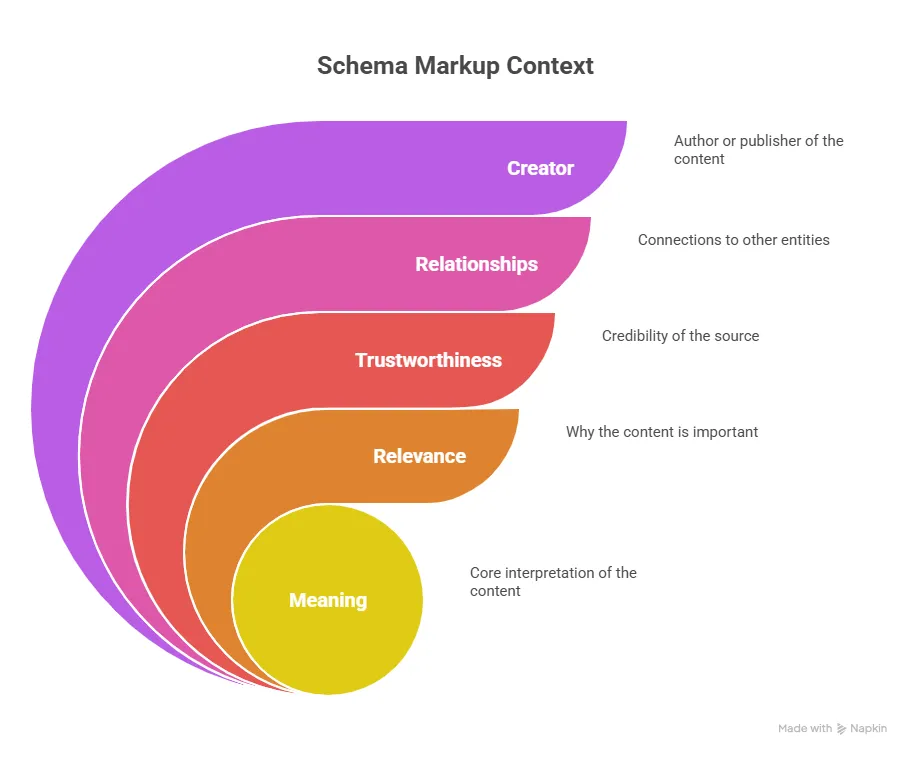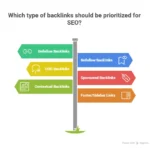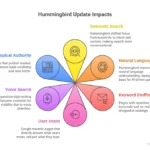Search engines understand content differently from humans. While people can easily grasp the meaning of a page, search engines need structured clues to interpret the context correctly.
That’s where Schema Markup comes in.
Schema Markup is a type of structured data added to a webpage to help search engines understand what the content means, not just what it says. It provides a clear description of entities, relationships, and attributes within a page.
For example:
- If a page talks about “Apple,” Schema helps search engines know whether it’s a fruit or the technology company.
- If a page has a “Review,” Schema tells Google the product reviewed, rating, and author.
Schema was developed through a collaboration between major search engines — Google, Bing, Yahoo, and Yandex — under the Schema.org project. It provides a standard vocabulary that can be used across websites.
Why Schema Markup Matters
Without Schema, search engines rely only on text and surrounding signals to interpret meaning. With Schema, they receive explicit context about:
- Who created the content
- What the content represents
- How it relates to other entities
- Why it should be considered relevant or trustworthy

This structured understanding allows Google and other engines to create rich results, such as:
- Ratings and reviews in SERPs
- FAQ and HowTo displays
- Event details
- Product information with prices
- Author and organization highlights
Schema doesn’t directly improve rankings, but it enhances how your content is understood, displayed, and trusted.
Different Formats of Schema
There are three main ways to implement Schema Markup:
- Microdata: Inline code within HTML tags (older and less flexible).
- RDFa: Rich metadata used in complex data applications.
- JSON-LD (JavaScript Object Notation for Linked Data):
- The preferred format by Google.
- Easier to implement and maintain.
- Can be placed in the
<head>or<body>section of a page.
Most modern websites, CMS platforms, and plugins like Yoast SEO or Rank Math automatically generate JSON-LD markup for basic entities.
Key Takeaway
Schema Markup is the language of structured understanding for search engines.
It bridges the gap between raw content and semantic meaning, helping your pages become more visible, trustworthy, and connected to the Knowledge Graph.
Evolution of Schema Markup
Schema Markup has evolved from a simple code language into a core part of how search engines understand the web. Its journey shows how SEO moved from keywords to entities, context, and relationships.
Early Days: Meta Tags and Microdata
In the beginning, search engines depended on meta tags and on-page text to identify page content.
But this approach had a problem — it lacked precision. Search engines often misunderstood context and relevance.
Then came Microdata and RDFa, which allowed webmasters to mark specific parts of a page (like reviews or addresses) using structured attributes.
While powerful, they were hard to manage at scale and cluttered the HTML code.
The Launch of Schema.org
In 2011, Google, Bing, Yahoo, and Yandex collaborated to create Schema.org, a shared vocabulary for structured data.
This was a major step. It created a unified standard for describing entities and their relationships across the web.
Schema.org introduced hundreds of types and properties to describe things like organizations, people, articles, products, reviews, and more.
It made structured data implementation easier and more consistent for search engines.
The Shift to JSON-LD
As websites became more complex, developers needed a simpler, cleaner way to add structured data.
Google later announced support for JSON-LD, a JavaScript-based format for structured data.
JSON-LD allowed webmasters to:
- Add schema without changing HTML structure.
- Manage data centrally in the
<head>section. - Use dynamic data through CMS or scripts.
Today, JSON-LD is the recommended format by Google and is supported across all major platforms and frameworks.
Schema in the Semantic Web and Knowledge Graph Era
With the rise of semantic search and entity-based indexing, Schema Markup became a key signal in how Google builds the Knowledge Graph.
Structured data now helps Google understand:
- Who an entity is (person, brand, organization)
- What it does (profession, products, services)
- How it connects to other entities (relationships and mentions)
This marked a major shift from traditional keyword SEO to semantic and entity-driven SEO.
The AI and Rich Results Stage
Today, Schema Markup powers much of what users see in search results — from rich snippets and FAQs to videos, products, and reviews.
With AI integration, search engines now use Schema to:
- Understand intent and context.
- Match results across text, video, and image content.
- Evaluate trustworthiness through verified entities.
As a result, Schema has become one of the most powerful tools for improving visibility, understanding, and E-E-A-T signals.
Key Takeaway
Schema Markup has evolved from a simple tagging system to the semantic backbone of modern SEO.
It connects your content to entities, context, and meaning — helping AI systems interpret your pages more intelligently.
How Schema Works in SEO
Schema Markup helps search engines understand the meaning behind your content.
It turns unstructured text into structured, machine-readable data that defines what the content represents and how it relates to known entities.
When used correctly, Schema improves both technical SEO and semantic understanding, leading to better visibility, higher trust, and richer search features.
1. Connecting Content with Meaning
Without Schema, search engines rely on guesswork.
With Schema, they receive a clear map of your page — including topics, authors, reviews, and relationships.
Example:
An article about “SEO strategies” with Schema can tell Google:
- It’s an Article type.
- Written by an Author entity linked to a verified profile.
- Published by an Organization with recognized authority.
- Contains Review, FAQ, or VideoObject elements.
This detailed structure helps Google understand not only what your page says, but who created it and why it’s trustworthy.
2. Enhancing E-E-A-T Signals
Schema supports Experience, Expertise, Authoritativeness, and Trustworthiness by explicitly defining:
- The author’s identity and credentials using the
Personschema. - The organization or publisher using
Organizationschema. - The datePublished,
sameAs, andaboutproperties to prove transparency and authenticity.
When Google’s systems detect consistent E-E-A-T signals across Schema and content, your page gains credibility and improved indexing quality.
3. Enabling Rich Results and SERP Enhancements
Schema data powers visual enhancements in search results known as rich results.
These include:
- Star ratings and reviews
- Product prices and availability
- FAQs and How-to steps
- Events and course listings
- Video previews and timestamps
These visual features increase click-through rate (CTR) and user engagement, even if rankings stay the same.
4. Strengthening Entity SEO
Schema transforms content into entities and relationships that feed the Knowledge Graph.
This process helps Google connect:
- Your brand to your website
- Your authors to their profiles
- Your services to their categories
- Your mentions to other verified sources
When your website is seen as part of a semantic network, it builds topical authority and contextual trust — both crucial in AI-driven search.
5. Helping AI Systems Interpret Your Content
AI algorithms like Google’s SGE (Search Generative Experience) use Schema to understand content meaning, relevance, and quality.
Structured data allows AI to:
- Retrieve factual details accurately.
- Identify verified sources and authors.
- Generate reliable answers based on entity connections.
Schema is no longer optional; it’s a bridge between human intent and machine understanding.
Key Takeaway
Schema Markup helps search engines and AI systems understand who, what, why, and how — the full context of your content.
It strengthens your E-E-A-T, improves visibility through rich results, and connects your brand to the broader web of entities and meaning.
Types of Schema Markup (with Examples)
Schema.org provides hundreds of types, but only a few are essential for most websites.
Each type helps search engines identify the purpose of the content and how it should appear in search results.
Here are the most common and effective Schema types every SEO professional should know.
4.1 Organization Schema
Defines details about a business or organization — name, logo, address, contact, and social profiles.
It helps Google connect your brand with your website and external entities.
Example (JSON-LD):
<script type="application/ld+json">
{
"@context": "https://schema.org",
"@type": "Organization",
"name": "Brain Cyber Solutions",
"url": "https://www.braincybersolutions.com",
"logo": "https://www.braincybersolutions.com/logo.png",
"sameAs": [
"https://www.facebook.com/braincybersolutions",
"https://www.linkedin.com/company/braincybersolutions"
],
"contactPoint": {
"@type": "ContactPoint",
"telephone": "+91-9999999999",
"contactType": "customer service"
}
}
</script>
4.2 Person (Author) Schema
Used to define the author or key individual behind content.
It supports E-E-A-T by validating who created the content.
Example:
<script type="application/ld+json">
{
"@context": "https://schema.org",
"@type": "Person",
"name": "Syam K S",
"jobTitle": "SEO Expert",
"url": "https://www.braincybersolutions.com",
"sameAs": [
"https://www.linkedin.com/in/syamks",
"https://x.com/syamks"
]
}
</script>
4.3 Article or BlogPosting Schema
Used for news, blogs, and educational content.
It helps Google show your article in enhanced results with the author, date, and headline.
Example:
<script type="application/ld+json">
{
"@context": "https://schema.org",
"@type": "BlogPosting",
"headline": "Understanding Schema Markup in SEO",
"description": "A detailed guide to schema markup and its role in SEO.",
"image": "https://www.example.com/schema-guide.jpg",
"author": {
"@type": "Person",
"name": "Syam K S"
},
"publisher": {
"@type": "Organization",
"name": "Brain Cyber Solutions",
"logo": {
"@type": "ImageObject",
"url": "https://www.braincybersolutions.com/logo.png"
}
},
"datePublished": "2025-10-25"
}
</script>
4.4 LocalBusiness Schema
Used for local SEO. Defines details about a business location, including address, phone, and map coordinates.
Example:
<script type="application/ld+json">
{
"@context": "https://schema.org",
"@type": "LocalBusiness",
"name": "Brain Cyber Solutions",
"image": "https://www.braincybersolutions.com/logo.png",
"address": {
"@type": "PostalAddress",
"streetAddress": "Smart City, Kakkanad",
"addressLocality": "Kochi",
"addressRegion": "Kerala",
"postalCode": "682030",
"addressCountry": "IN"
},
"telephone": "+91-9999999999",
"openingHours": "Mo-Fr 09:00-18:00"
}
</script>
4.5 FAQ Schema
Helps show frequently asked questions in the SERP as dropdown results.
This improves visibility and CTR.
Example:
<script type="application/ld+json">
{
"@context": "https://schema.org",
"@type": "FAQPage",
"mainEntity": [{
"@type": "Question",
"name": "What is Schema Markup?",
"acceptedAnswer": {
"@type": "Answer",
"text": "Schema Markup is structured data that helps search engines understand content meaning."
}
},{
"@type": "Question",
"name": "Does Schema improve SEO ranking?",
"acceptedAnswer": {
"@type": "Answer",
"text": "Schema does not directly affect ranking but improves visibility and click-through rate."
}
}]
}
</script>
4.6 Product Schema
Used for eCommerce or product pages. Displays product details like price, brand, and reviews in search results.
Example:
<script type="application/ld+json">
{
"@context": "https://schema.org",
"@type": "Product",
"name": "AI SEO Course",
"image": "https://www.example.com/seo-course.jpg",
"description": "Learn advanced SEO and AI-based optimization strategies.",
"brand": {
"@type": "Brand",
"name": "Brain Cyber Solutions"
},
"aggregateRating": {
"@type": "AggregateRating",
"ratingValue": "4.9",
"reviewCount": "320"
},
"offers": {
"@type": "Offer",
"priceCurrency": "INR",
"price": "2999",
"availability": "https://schema.org/InStock"
}
}
</script>
4.7 Review & Rating Schema
Displays user reviews and ratings that increase credibility and engagement.
4.8 Course, Event, JobPosting, Video & HowTo Schema
Other popular types:
- Course: For online programs or tutorials.
- Event: For webinars, workshops, and conferences.
- JobPosting: For open positions.
- Video: To show video content in search with thumbnails.
- HowTo: For step-by-step guides and tutorials.
Key Takeaway
Every Schema type communicates a specific intent to search engines.
Use types relevant to your content and maintain accuracy, consistency, and contextual alignment to strengthen E-E-A-T and entity recognition.
Advanced and New Schema Types
Search engines now focus on context, credibility, and user intent rather than just keywords.
To support this shift, Schema.org has introduced several advanced and modern schema types.
These types help search engines understand voice content, AI transparency, learning resources, and factual claims with greater accuracy.
5.1 Speakable Schema
The Speakable schema identifies parts of your content suitable for text-to-speech and voice assistants like Google Assistant or Alexa.
It helps your content get featured in voice search results.
Ideal for: News sites, blogs, and FAQs.
Example:
<script type="application/ld+json">
{
"@context": "https://schema.org",
"@type": "NewsArticle",
"headline": "Latest SEO Trends",
"speakable": {
"@type": "SpeakableSpecification",
"xpath": [
"/html/head/title",
"/html/body/p[1]"
]
},
"url": "https://www.example.com/latest-seo-trends"
}
</script>
SEO Advantage:
Boosts visibility in voice search and smart devices, improving your brand’s presence in emerging AI-driven channels.
5.2 LearningResource and CourseInstance Schema
These are vital for e-learning platforms and educational content.
They describe courses, instructors, learning materials, and delivery formats.
Example:
<script type="application/ld+json">
{
"@context": "https://schema.org",
"@type": "Course",
"name": "Advanced SEO and AI Optimization",
"description": "Master AI-based SEO strategies with live projects.",
"provider": {
"@type": "Organization",
"name": "Brain Cyber Solutions",
"sameAs": "https://www.braincybersolutions.com"
},
"hasCourseInstance": {
"@type": "CourseInstance",
"courseMode": "Online",
"startDate": "2025-11-15",
"instructor": {
"@type": "Person",
"name": "Syam K S"
}
}
}
</script>
SEO Advantage:
Improves education-related visibility and helps your course content appear in Google’s learning results and Knowledge Panels.
5.3 FactCheck and ClaimReview Schema
Used for verifying factual content, claims, or news stories.
It builds trust and transparency — key parts of E-E-A-T.
Example:
<script type="application/ld+json">
{
"@context": "https://schema.org",
"@type": "ClaimReview",
"author": {
"@type": "Organization",
"name": "Brain Cyber Solutions"
},
"claimReviewed": "Schema markup directly improves rankings.",
"reviewRating": {
"@type": "Rating",
"ratingValue": "2",
"bestRating": "5",
"worstRating": "1"
},
"url": "https://www.example.com/schema-myths"
}
</script>
SEO Advantage:
Boosts credibility and fact integrity, helping your site gain authority in YMYL (Your Money or Your Life) and informational niches.
5.4 AI-Generated Content and Transparency Schema
As AI-generated content grows, Google encourages structured disclosure for transparency.
Although still evolving, Schema.org supports identifying AI-assisted or AI-generated material through custom extensions and properties like "creator" and "isBasedOn".
Purpose:
To help AI systems and search engines differentiate between human-created and AI-assisted content, supporting authenticity and E-E-A-T.
5.5 Entity-Based Schema (Advanced Relationships)
Modern SEO focuses on entities and their relationships.
You can use Schema to define how one entity connects to another — for example:
Person→worksFor→OrganizationOrganization→owns→ProductArticle→about→Topic
Example:
{
"@context": "https://schema.org",
"@type": "Person",
"name": "Syam K S",
"worksFor": {
"@type": "Organization",
"name": "Brain Cyber Solutions"
},
"knowsAbout": ["SEO", "Digital Marketing", "Artificial Intelligence"]
}
SEO Advantage:
Helps Google connect your website, brand, and authors to verified entities in the Knowledge Graph, improving semantic authority and trust signals.
Key Takeaway
Modern Schema types go beyond rich results.
They enhance AI understanding, trust, voice visibility, and topical authority.
By using advanced Schema properties, you help search engines understand your content’s purpose, authenticity, and expertise at a deeper level.
How Schema Markup Builds E-E-A-T and Topical Authority
Schema Markup is not just about rich snippets anymore.
It plays a big role in building E-E-A-T (Experience, Expertise, Authoritativeness, and Trustworthiness) — the core quality framework used by Google to evaluate content and publishers.
When implemented properly, Schema helps search engines confirm who you are, what you do, and why your content is trustworthy.
6.1 Connecting Expertise and Author Identity
By marking up your author and organization profiles with Schema, Google can verify your identity and background.
This helps link your content to reliable human or organizational entities.
You can use:
PersonSchema for author details.OrganizationSchema for company information.sameAsproperty to connect profiles (LinkedIn, YouTube, Crunchbase, etc.).
Example:
{
"@context": "https://schema.org",
"@type": "Person",
"name": "Syam K S",
"jobTitle": "SEO Specialist and AI Consultant",
"worksFor": {
"@type": "Organization",
"name": "Brain Cyber Solutions"
},
"sameAs": [
"https://www.linkedin.com/in/syamks",
"https://www.braincybersolutions.com"
]
}
Why it matters:
Google can connect your author profile to your topical footprint across multiple domains, supporting topical authority and entity consistency.
6.2 Organization and Publisher Reputation
Adding structured data for your organization helps Google recognize brand authority and credibility.
You can include:
- Founding date
- Founder information
- Contact details
- Awards
- Mentions or certifications
Example:
{
"@context": "https://schema.org",
"@type": "Organization",
"name": "Brain Cyber Solutions",
"url": "https://www.braincybersolutions.com",
"logo": "https://www.braincybersolutions.com/logo.png",
"founder": {
"@type": "Person",
"name": "Syam K S"
},
"sameAs": [
"https://www.linkedin.com/company/braincybersolutions",
"https://www.facebook.com/braincybersolutions"
]
}
Result:
Your brand sends trust signals that reinforce E-E-A-T both on-page and across external platforms.
6.3 Content-Level Trust and Transparency
Schema types like Review, AggregateRating, FactCheck, and Citation markups show transparency.
These indicate that your content is verified, reviewed, or backed by credible sources.
Example:
An article with expert reviews or citations can use:
{
"@context": "https://schema.org",
"@type": "Review",
"reviewBody": "This SEO course offers practical, AI-driven optimization strategies.",
"author": {
"@type": "Person",
"name": "John Mathew"
},
"itemReviewed": {
"@type": "Course",
"name": "Advanced SEO and AI Optimization"
},
"reviewRating": {
"@type": "Rating",
"ratingValue": "5"
}
}
SEO Benefit:
Schema makes trust measurable.
When search engines see structured trust data, they treat the page as reliable and user-focused.
6.4 Linking Schema with Topical Authority
Topical authority is built by publishing interconnected, relevant, and expert-level content on a theme.
Schema reinforces this by:
- Defining how each article relates to a core topic.
- Associating authors with specific fields of knowledge.
- Helping Google build topic clusters around your brand and authors.
Using "about", "mentions", and "knowsAbout" properties, you can signal your topical relevance clearly.
Example:
{
"@context": "https://schema.org",
"@type": "Article",
"headline": "Entity SEO Explained",
"about": {
"@type": "Thing",
"name": "Entity SEO"
},
"mentions": [
{
"@type": "Thing",
"name": "Knowledge Graph"
},
{
"@type": "Thing",
"name": "Semantic Search"
}
],
"author": {
"@type": "Person",
"name": "Syam K S"
}
}
Outcome:
This helps Google understand your topic map, linking your site to specific knowledge areas and expertise zones.
Key Takeaway
Schema markup amplifies your E-E-A-T and topical authority by building a machine-readable reputation layer.
It proves your authorship, expertise, and brand credibility, helping you earn better visibility, trust, and ranking signals.
Conclusion
Schema Markup has become one of the most important foundations of modern SEO.
It helps search engines understand content meaning, relationships, and trust signals instead of just focusing on keywords.
In the new era of AI and semantic search, Schema plays a central role in how Google and other search systems connect entities — people, organizations, topics, and places — to build accurate search experiences.
By using Schema, you:
- Improve visibility and CTR through rich results.
- Strengthen E-E-A-T and brand credibility.
- Help AI systems and Knowledge Graphs connect your content to verified entities.
- Enhance topical relevance and semantic understanding.
Schema is not a one-time setup. It must grow with your content, site structure, and topical evolution.
Keep your markup valid, updated, and connected to real entities that represent authentic expertise.
If you integrate Schema strategically across your articles, courses, reviews, and profiles, your site can become a recognized entity source in your niche — trusted by both users and search engines.

